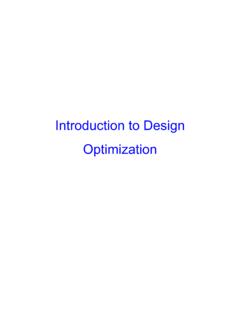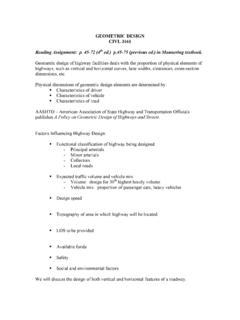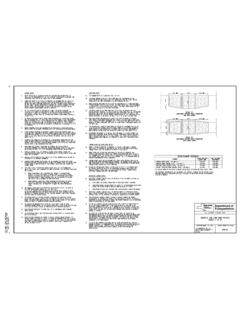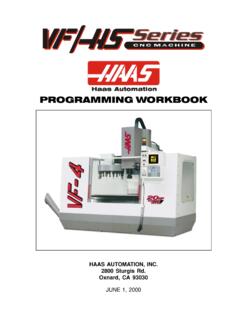Transcription of COMPUTER NUMERICAL CONTROL PROGRAMMING BASICS
1 COMPUTERNUMERICALCONTROLPROGRAMMINGBASIC SA Primer for theSkillsUSA/VICAC hampionshipsSteve Krar Arthur GillDistributed to educational administrators,instructors, students, and apprentices with the compliments of INDUSTRIAL PRESS, of MACHINERY S HANDBOOK The Bible of the Machine Trades ComputerNumericalControlProgrammingBasic sSteve Krar Arthur GillThis book is not intended for sale under any PRESS Madison Avenue, New York, NY 10016 CONTENTSSECTIONPAGEF oreword1 Preface7 Cartesian Coordinate System7 Machines Using CNC9 PROGRAMMING Systems11 Point-to-Point or Continuous Path13 Point-to-Point Positioning14 Continuous Path (Contouring)
2 15 Interpolation15 PROGRAMMING Format17 PROGRAMMING for Positioning23 Work Settings and Offsets26 CNC Bench-Top Milling and turning Centers30 CNC PROGRAMMING Hints Milling32 Milling and Drilling Programming34 CNC PROGRAMMING Hints Turning38 Fanuc Compatible Programming39 turning Programming407 The term NUMERICAL CONTROL is a widely accepted and commonlyused term in the machine tool industry. NUMERICAL CONTROL (NC)enables an operator to communicate with machine tools through aseries of numbers and which quickly became COMPUTER NUMERICAL CONTROL (CNC) hasbrought tremendous changes to the metalworking industry.
3 Newmachine tools in CNC have enabled industry to consistentlyproduce parts to accuracies undreamed of only a few years same part can be reproduced to the same degree of accuracyany number of times if the CNC program has been properly pre-pared and the COMPUTER properly programmed. The operatingcommands which CONTROL the machine tool are executed automati-cally with amazing speed, accuracy, efficiency, and ever-increasing use of CNC in industry has created a need forpersonnel who are knowledgeable about and capable of preparingthe programs which guide the machine tools to produce parts tothe required shape and accuracy.
4 With this in mind, the authorshave prepared this textbook to take the mystery out of CNC - toput it into a logical sequence and express it in simple languagethat everyone can understand. The preparation of a program isexplained in a logical step-by-step procedure, with practical ex-amples to guide the Coordinate SystemAlmost everything that can be produced on a conventional ma-chine tool can be produced on a COMPUTER NUMERICAL controlmachine tool, with its many advantages. The machine tool move-ments used in producing a product are of two basic types: point-to-point (straight-line movements) and continuous path (contouringmovements).
5 The Cartesian, or rectangular, coordinate system was devised bythe French mathematician and philosopher Rene Descartes. Withthis system, any specific point can be described in mathematicalPreface8terms from any other point along three perpendicular axes. Thisconcept fits machine tools perfectly since their construction isgenerally based on three axes of motion (X, Y, Z) plus an axis ofrotation. On a plain vertical milling machine, the X axis is thehorizontal movement (right or left) of the table, the Y axis is thetable cross movement (toward or away from the column), and theZ axis is the vertical movement of the knee or the spindle.
6 CNCsystems rely heavily on the use of rectangular coordinates be-cause the programmer can locate every point on a job points are located on a workpiece, two straight intersectinglines, one vertical and one horizontal, are used. These lines mustbe at right angles to each other, and the point where they cross iscalled the origin, or zero point (Fig. 1)Fig. 1 Intersecting lines form right angles andestablish the zero point (Allen-Bradley)The three-dimensional coordinate planes are shown in Fig. 2. TheX and Y planes (axes) are horizontal and represent horizontalmachine table motions. The Z plane or axis represents the verticaltool motion.
7 The plus (+) and minus (-) signs indicate the directionfrom the zero point (origin) along the axis of movement. The fourquadrants formed when the XY axes cross are numbered in acounterclockwise direction (Fig. 3). All positions located in quad-rant 1 would be positive (X+) and positive (Y+). In the secondquadrant, all positions would be negative X (X-) and positive (Y+).In the third quadrant, all locations would be negative X (X-) andnegative (Y-). In the fourth quadrant, all locations would be posi-tive X (X+) and negative Y (Y-).Fig. 2 The three-dimensionalcoordinate planes (axes) used inCNC.
8 (The Superior ElectricCompany)9 Fig. 3 The quadrants formed when the X and Y axes cross are used to accurately locatepoints from the XY zero, or origin, point. (Allen-Bradley)In Fig. 3 , point A would be 2 units to the right of the Y axis and 2units above the X axis. Assume that each unit equals Thelocation of point A would be X + and Y + For point B,the location would be X + and Y - In CNC program-ming it is not necessary to indicate plus (+) values since these areassumed. However, the minus (-) values must be indicated. Forexample, the locations of both A and B would be indicated Using CNCE arly machine tools were designed so that the operator wasstanding in front of the machine while operating the controls.
9 Thisdesign is no longer necessary, since in CNC the operator nolonger controls the machine tool movements. On conventionalmachine tools, only about 20 percent of the time was spent remov-ing material. With the addition of electronic controls, actual timespent removing metal has increased to 80 percent and evenhigher. It has also reduced the amount of time required to bringthe cutting tool into each machining TypesLatheThe engine lathe, one of the most productive machine tools, hasalways been an efficient means of producing round parts ( ). Most lathes are programmed on two axes. The X axis controls the cross motion of the cutting X (X-) moves the tool towards the spindlecenterline; positive X moves the tool away from the spindlecenterline.
10 The Z axis controls the carriage travel toward or away fromthe 4 The main axes of a lathe or turning center . (Emco Maier Corp)Milling MachineThe milling machine has always been one of the most versatilemachine tools used in industry (Fig. 5). Operations such asmilling, contouring, gear cutting, drilling, boring, and reaming areonly a few of the many operations which can be performed on amilling machine. The milling machine can be programmed onthree axes: The X axis controls the table movement left or right. The Y axis controls the table movement toward or away fromthe column. The Z axis controls the vertical (up or down) movement ofthe knee or 5 The main axes of a vertical machining center .










